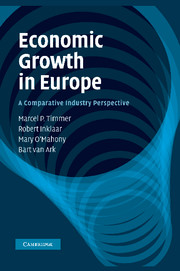Book contents
- Frontmatter
- Contents
- List of figures
- List of tables
- Preface and acknowledgements
- 1 Introduction and overview
- 2 Economic growth in Europe
- 3 EU KLEMS database
- 4 Structural change
- 5 The industry origins of aggregate growth
- 6 Productivity levels and convergence
- 7 Drivers of productivity growth in Europe
- References
- Index
5 - The industry origins of aggregate growth
Published online by Cambridge University Press: 06 December 2010
- Frontmatter
- Contents
- List of figures
- List of tables
- Preface and acknowledgements
- 1 Introduction and overview
- 2 Economic growth in Europe
- 3 EU KLEMS database
- 4 Structural change
- 5 The industry origins of aggregate growth
- 6 Productivity levels and convergence
- 7 Drivers of productivity growth in Europe
- References
- Index
Summary
Introduction
The purpose of this chapter is to examine in more detail the industry origins of growth. This involves analysing how the growth of inputs and MFP of each industry contributes to aggregate value added. Thus we not only look at which industries contribute most to productivity growth but also which industries contribute most to the increased use of ICT and skilled labour. In addition, we will provide analyses based on data for twenty-six detailed industries, rather than for broad sectors as done so far. These yield much richer information on the sources of growth than those in earlier chapters as the latter could miss sizeable within-group heterogeneity. As before, we focus on two areas: the performance of the European Union over the period 1980–2005, and a comparison of the EU with the USA for the 1995–2005 period.
The chapter is organised as follows. Section 5.2 outlines the methodology used to determine industries' contributions to aggregate growth. This is based on the direct aggregation over industries approach, outlined in Jorgenson et al. (2005). Section 5.3 examines labour productivity trends at the industry level and analyses contributions to aggregate productivity growth in the EU and USA. In the following sections this contribution is further dissected. In section 5.4 the contribution of input growth in industries to aggregate growth is determined for ICT capital, non-ICT capital and labour composition separately. Section 5.5 is devoted to the contributions from industry-level multi-factor productivity (MFP) growth.
- Type
- Chapter
- Information
- Economic Growth in EuropeA Comparative Industry Perspective, pp. 152 - 188Publisher: Cambridge University PressPrint publication year: 2010



